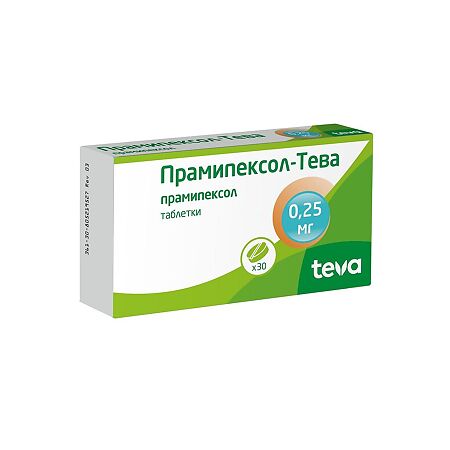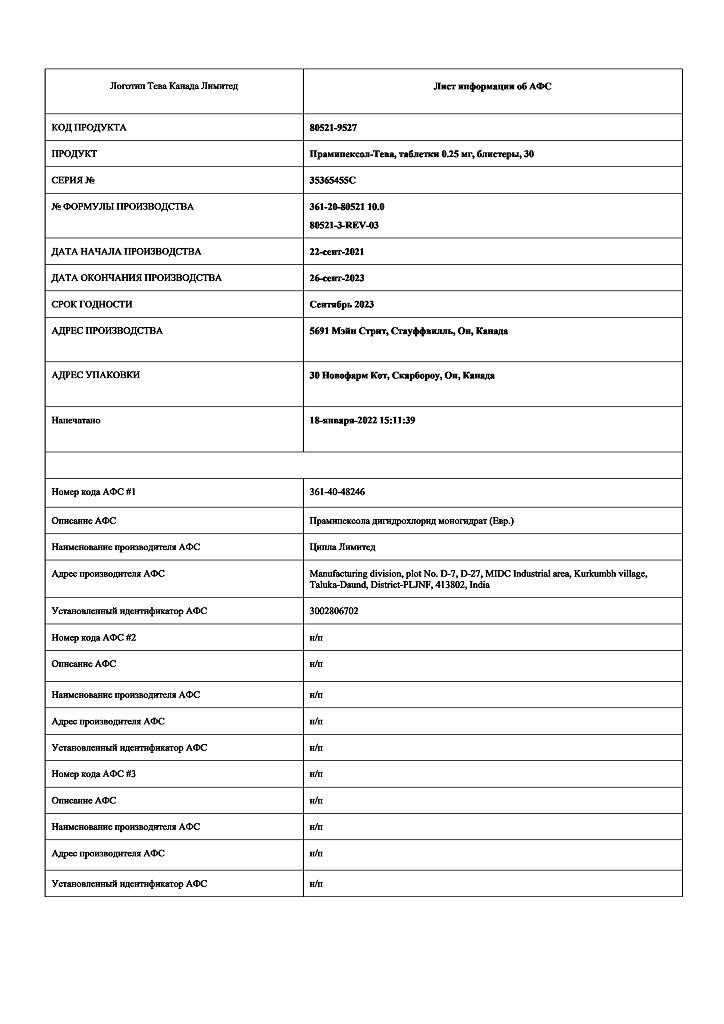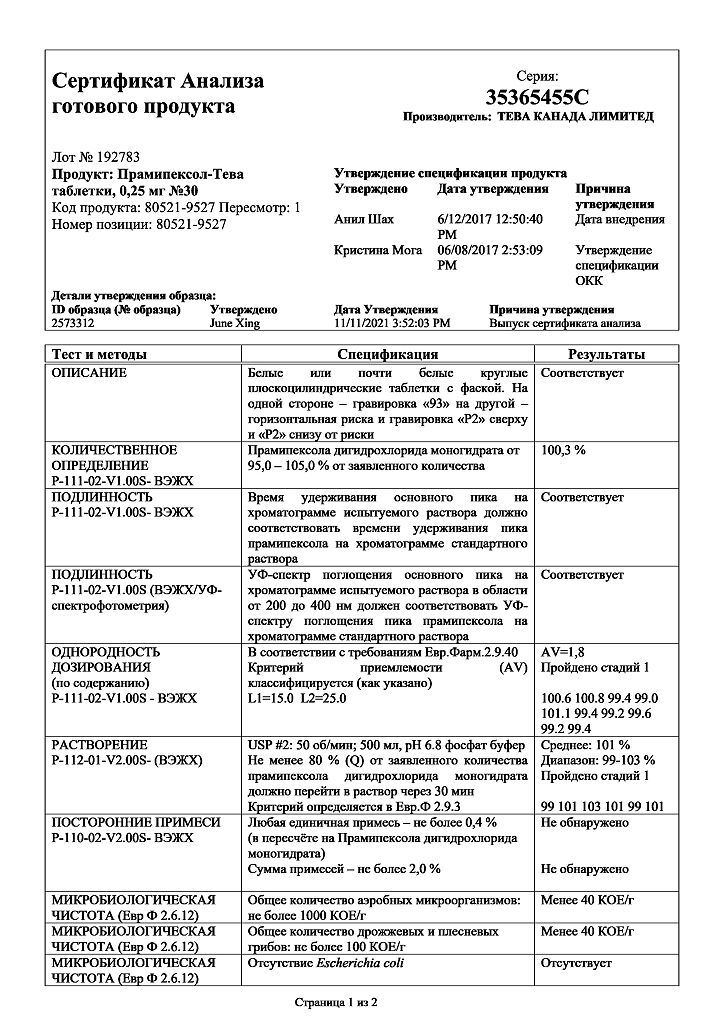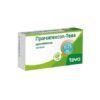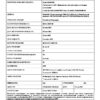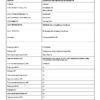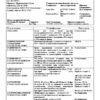No products in the cart.
Pramipexole-Teva, tablets 0.25 mg 30 pcs
€7.97 €6.97
Out of stock
(E-mail when Stock is available)
Description
Pharmacotherapeutic group: antiparkinsonian drug – dopamine agonist.
ATX code: N04BC05
Pharmacological properties.
Pharmacodynamics
Pramipexole is a dopamine receptor agonist, binds with high selectivity and specificity to dopamine D2 receptors and has a strong affinity for dopamine D3 receptors.
Limits motor deficits in Parkinson’s disease by stimulating dopamine receptors in the striatum.
Pramipexole inhibits dopamine synthesis, release and metabolism and protects dopaminergic neurons from degeneration occurring in response to ischemia or methamphetamine neurotoxicity.
In clinical studies, pramipexole therapy has been shown to be effective in the later stages of Parkinson’s disease, with a significant reduction in motor impairment and significantly later development of complications compared to levodopa monotherapy.
Pharmacokinetics
absorption. Pramipexole is rapidly and completely absorbed after oral administration, reaching maximum plasma concentration (Cmax) in approximately 1-3 hours. Absolute bioavailability of pramipexole exceeds 90%. Absorption rate is reduced with food, but total absorption is not affected by food intake. Pramipexole is characterized by linear kinetics and relatively little variability in concentrations between individual patients.
Distribution. The volume of distribution (Vd) is 400 liters. Binding to plasma proteins is less than 20%.
Metabolism and excretion. Slightly metabolized in the body. About 90% of the dose is excreted by the kidneys (80% – unchanged) and less than 2% – in the feces. Total clearance of pramipexole is about 500 ml/min, renal clearance is about 400 ml/min.
The value of the terminal elimination half-life (T1/2) is 8 hours in young healthy volunteers and about 12 hours – in elderly people.
Indications
Indications
Symptomatic treatment of Parkinson’s disease as monotherapy or in combination with levodopa drugs in the late stage of the disease, when the effects of levodopa are weakened or become inconsistent and fluctuations in the therapeutic effect (on-off) occur.
Pharmacological effect
Pharmacological effect
Pharmacotherapeutic group: antiparkinsonian drug – dopamine agonist.
ATC code: N04BC05
Pharmacological properties
Pharmacodynamics
Pramipexole is a dopamine receptor agonist, binds to dopamine D2 receptors with high selectivity and specificity, and has a pronounced affinity for dopamine D3 receptors.
Reduces deficits in motor activity in Parkinson’s disease by stimulating dopamine receptors in the striatum.
Pramipexole inhibits the synthesis, release and metabolism of dopamine, protecting dopaminergic neurons from degeneration that occurs in response to ischemia or methamphetamine neurotoxicity.
Clinical studies have shown the effectiveness of pramipexole therapy in late stages of Parkinson’s disease, in which there was a significant reduction in the number of motor disorders and a significantly later development of complications compared with levodopa monotherapy.
Pharmacokinetics
Suction. Pramipexole is rapidly and completely absorbed after oral administration, reaching maximum plasma concentrations (Cmax) in approximately 1-3 hours. The absolute bioavailability of pramipexole exceeds 90%. The rate of absorption decreases with food intake, but the total amount of absorption is not affected by food intake. Pramipexole has linear kinetics and relatively little variability in concentrations between individual patients.
Distribution. The distribution volume (Vd) is 400 l. Plasma protein binding – less than 20%.
Metabolism and excretion. Slightly metabolized in the body. About 90% of the dose is excreted by the kidneys (80% unchanged) and less than 2% in feces. The total clearance of pramipexole is about 500 ml/min, renal clearance is about 400 ml/min.
The terminal half-life (T1/2) is 8 hours in young healthy volunteers and about 12 hours in elderly people.
Special instructions
Special instructions
Kidney failure. In patients with renal failure, a dose reduction of Pramipexole-Teva is recommended.
Hallucinations. Hallucinations and confusion are characteristic adverse reactions during treatment with dopamine receptor agonists and levodopa. Hallucinations are more common when treated with pramipexole in combination with levodopa in patients with advanced Parkinson’s disease than when treated alone in patients with early-stage Parkinson’s disease. Patients should be informed that hallucinations (mainly visual) may develop. Patients should be warned that hallucinations may occur that may affect the ability to drive.
Impulse control disorders. Patients and those caring for them should be aware that signs of abnormal behavior (impulsive and compulsive actions), such as overeating, compulsive shopping (pathological shopping), hypersexuality and pathological gambling, may occur in connection with the treatment of patients with dopaminergic drugs. In such cases, a decision should be made to reduce the dose/gradually discontinue treatment.
Mania and delirium. Patients should be monitored regularly for the development of mania or delirium. Patients and their caregivers should be aware that mania and delirium may occur in patients taking pramipexole. If such symptoms develop, the issue of reducing the dose of the drug or discontinuing it should be decided.
Patients with psychotic disorders. In patients with mental disorders, the prescription of dopamine agonists in combination with pramipexole is possible only after a preliminary assessment of the possible risk-benefit. Concomitant use of pramipexole and antipsychotic drugs is not recommended, for example, if a dopamine antagonistic effect is possible.
Ophthalmological monitoring. If visual disturbances occur, regular ophthalmological examinations should be carried out.
Severe cardiovascular diseases. Caution must be exercised if the patient has severe cardiovascular disease. Due to the risk of orthostatic hypotension during dopaminergic therapy, it is recommended to monitor blood pressure, especially at the beginning of treatment.
Dyskinesia. When using pramipexole in combination with levodopa in the later stages of Parkinson’s disease, dyskinesia may develop at the initial stage of dose selection, if which occurs, the dose of levodopa must be reduced.
Sudden falling asleep and drowsiness. Patients should be warned about the possible sedative effects of pramipexole, including drowsiness and sudden sleepiness during daytime activities. Patients should be advised that if excessive sleepiness or episodes of sudden falling asleep during daytime activities (eg, talking, eating), which may occur at any time during treatment, occur, they should not drive or participate in potentially hazardous activities and should consult their physician. Due to the possibility of additive effects, caution should be exercised when taking other sedative medications or alcohol at the same time as pramipexole.
Melanoma. Epidemiological studies have shown that patients with Parkinson’s disease have a high risk (2 to approximately 6 times higher) of developing melanoma than the general population. Whether this increased risk is due to Parkinson’s disease or is related to other factors, such as medications used for Parkinson’s disease, is unknown. For the reasons given above, patients and those caring for them should be informed that they should be alert to the possibility of developing melanoma while taking pramipexole or other dopaminergic drugs.
Neuroleptic malignant syndrome. There are reports that symptoms of neuroleptic malignant syndrome may occur if dopaminergic drug therapy is abruptly discontinued.
Residues of the drug in the feces. Some patients have reported having residue in their feces that resembled whole tablets of the drug. If a patient reports such an event, the physician should reassess the patient’s response to treatment.
Reports in the literature indicate that treatment of restless legs syndrome with dopaminergic drugs may lead to an increase in its severity. This increase represented an earlier onset of symptoms in the evening (or even in the afternoon), worsening of symptoms, and spread of symptoms to other extremities. However, in a 26-week controlled clinical trial specifically dedicated to studying this effect, there was no significant difference in the increase in clinical symptoms between the pramipexole and placebo groups.
Impact on the ability to drive vehicles and machinery
Pramipexole-Teva may have a significant effect on your ability to drive a car or operate technical devices. Due to the possibility of developing drowsiness and hallucinations, in order to avoid episodes of falling asleep, patients taking the drug should refrain from driving and operating machinery that require increased concentration and speed of psychomotor reactions for the duration of treatment or until symptoms of relapse of the disease and signs of drowsiness disappear.
Active ingredient
Active ingredient
Pramipexole
Composition
Composition
1 tablet contains: active ingredient: pramipexole dihydrochloride monohydrate 0.125 mg/0.25 mg/0.50 mg/1.00 mg; excipients: mannitol 35.185 mg/70.37 mg/140.74 mg/140.24 mg; microcrystalline cellulose type 101 (PH 101) 18.00 mg/36.00 mg/72.00 mg/72.00 mg; sodium carboxymethyl starch (type A) 3.00 mg/6.00 mg/12.00 mg/12.00 mg; povidone-K25 1.80 mg/3.60 mg/7.20 mg/7.20 mg; colloidal silicon dioxide 0.30 mg/0.60 mg/1.20 mg/1.20 mg; magnesium stearate 0.57 mg/1.14 mg/2.28 mg/2.28 mg; sodium stearyl fumarate 1.02 mg/2.04 mg/4.08 mg/4.08 mg.
Pregnancy
Pregnancy
Pregnancy
The effect on pregnancy and lactation in humans has not been studied.
The possible effects of pramipexole on reproductive function have been studied in animal experiments. Pramipexole does not show teratogenicity in rats and rabbits, but at doses toxic to pregnant females, it was embryotoxic in rats. The drug should not be prescribed during pregnancy.
Breastfeeding
The excretion of pramipexole into breast milk has not been studied. Since pramipexole inhibits prolactin secretion, it is possible that it also suppresses lactation. Therefore, the drug should not be taken during breastfeeding.
Contraindications
Contraindications
hypersensitivity to pramipexole or any of the components of the drug;
breastfeeding period;
age up to 18 years.
With caution: renal failure; arterial hypotension; cardiovascular diseases; simultaneous use with dopamine receptor agonists, sedatives, cimetidine, amantadine, ethanol; pregnancy.
Side Effects
Side Effects
In patients with Parkinson’s disease, frequent adverse reactions (≥ 5%) when treated with pramipexole were nausea, dyskinesia, hypotension, dizziness, somnolence, insomnia, constipation, hallucinations, headache and fatigue. The incidence of somnolence increased with doses of 1.5 mg per day. A common adverse reaction when taking the drug in combination with levodopa was dyskinesia. Hypotension may occur early in treatment, especially if the dosage of pramipexole is titrated too quickly.
Table 1. The most common adverse reactions when using pramipexole in patients with Parkinson’s disease
Organ system
Frequency
Adverse reaction
Nervous system disorders
very often
dizziness, dyskinesia, drowsiness
often
headache
rarely
amnesia, hyperkinesia, sudden attack of drowsiness, fainting
Endocrine system disorders
rarely
impaired secretion of antidiuretic hormone*
Heart disorders
often
arterial hypotension
rarely
heart failure1
Gastrointestinal tract disorders
very often
nausea
often
constipation, vomiting
Mental disorders
often
sleep disturbances, symptoms of motivational control disorder and compulsive behavior, confusion, hallucinations, insomnia
rarely
overeating1, pathological attraction to shopping, pathological attraction to gambling, hyperphagia1, mania, hypersexuality; libido disorders (increase or decrease), paranoia, anxiety
Disorders of the respiratory system, chest and mediastinal organs
rarely
shortness of breath, hiccups
Vision disorders
often
Visual impairment, including diplopia, blurred vision and decreased visual acuity
Skin and subcutaneous tissue disorders
rarely
hypersensitivity, itching, rash
Infectious and parasitic diseases
rarely
pneumonia
General disorders and disorders at the injection site
often
fatigue, peripheral edema
Violations identified during special studies
often
loss of body weight, loss of appetite
rarely
increase in body weight
1 Adverse reaction during the post-registration period. In 95% of cases, the frequency is not higher than ≥1/1000-<1/100, but may be lower. Establishing an exact frequency is not possible because the adverse reaction was not identified during clinical trials among 2762 patients with Parkinson's disease who took pramipexole.
Drowsiness. The use of pramipexole is often accompanied by drowsiness and infrequently by excessive daytime sleepiness and cases of sudden sleep onset. Motivation control disorders and compulsive behavior. In a cross-sectional retrospective screening and case-control study of 3090 patients with Parkinson’s disease, 13.6% of patients receiving dopaminergic or nondopaminergic therapy reported symptoms of motivational control disorder in the past 6 months, including pathological gambling, compulsive shopping, excessive food cravings, and compulsive sexual behavior. behavior (hypersexuality). Possible independent risk factors for motivational control disorders included dopaminergic therapy, age <65 years, unmarried status, and a family history of self-reported pathological gambling.
Heart failure. In post-marketing clinical studies, heart failure occurred in selected patients receiving pramipexole. In a pharmacoepidemiological study, pramipexole use was associated with an increased risk of heart failure compared with no use (hazard ratio, 1.86; 95% CI, 1.21-2.85).
If any of the adverse reactions indicated in the instructions worsen, or you notice any other adverse reactions not listed in the instructions, tell your doctor.
Table 2. The most common adverse reactions when using pramipexole in patients with restless legs syndrome.
Organ system
Frequency
Side effect
Nervous system disorders
often
dizziness, headache, drowsiness
rarely
amnesia, dyskinesia, hyperkinesia, sudden falling asleep, fainting
Endocrine system disorders
rarely
impaired secretion of antidiuretic hormone2
Heart disorders
rarely
heart failure
Vascular disorders
rarely
lowering blood pressure
Mental disorders
often
abnormal dreams, insomnia
rarely
behavioral disorders (symptoms of impulsive and compulsive actions), such as: compulsive overeating, compulsive shopping, delusions, hyperphagia, hypersexuality, confusion, hallucinations, sexual desire disorders, paranoia, anxiety, pathological gambling
Infectious and parasitic diseases
rarely
pneumonia
Vision disorders
rarely
visual impairment, including diplopia, decreased visual acuity and clarity of perception
Disorders of the respiratory system, chest and mediastinal organs
rarely
shortness of breath, hiccups
Gastrointestinal tract disorders
very often
nausea
often
constipation, vomiting
Skin and subcutaneous tissue disorders
rarely
itching, rash and other symptoms of hypersensitivity
General violations
often
fatigue
rarely
peripheral edema
Violations identified during special studies
rarely
decreased body weight, decreased appetite, increased body weight
2Side effects were observed during post-registration surveillance. With a 95% probability, the frequency category does not exceed “infrequently”, but may be lower.
A precise estimate of the frequency category is not possible because adverse reactions were not recorded in the clinical trial database containing information on 1395 patients with restless legs syndrome who received pramipexole.
Interaction
Interaction
Binding to blood proteins. Pramipexole binds to plasma proteins to a small extent (less than 20%) and undergoes biotransformation. Therefore, interactions with other drugs that affect plasma protein binding or elimination due to biotransformation are unlikely. Interactions with anticholinergic drugs and amantadine have not been studied. However, interaction with amantadine is possible, because drugs have a similar mechanism of elimination. Anticholinergic drugs are primarily metabolized, so interactions with pramipexole are unlikely.
No pharmacokinetic interaction with seleginine or levodopa was noted.
Inhibitors/competitors of the active pathway of drug excretion by the kidneys. Cimetidine reduces the renal clearance of pramipexole by approximately 34%, probably due to inhibition of the renal tubular cationic secretory transport system. Therefore, drugs that are inhibitors of this metabolic pathway for active renal excretion of the drug or are eliminated by this pathway, such as cimetidine, amantadine, mexiletine, zidovudine, cisplatin, quinine and procainamide, may interact with pramipexole, which may lead to a decrease in drug clearance. The possibility of reducing the dose of pramipexole should be considered when taking these drugs simultaneously.
Combination with levodopa. When increasing the dose of the drug in patients with Parkinson’s disease, it is recommended to reduce the dose of levodopa, while the dose of other antiparkinsonian drugs must be maintained at a constant level. Due to possible additive effects, patients should be advised to exercise caution when taking other sedative drugs or ethanol in combination with pramipexole.
Antipsychotic drugs. Concomitant use of antipsychotic drugs and pramipexole is not recommended, for example, in the case of using drugs that are dopamine antagonists.
Overdose
Overdose
Symptoms: nausea, vomiting, hyperkinesia, hallucinations, agitation and decreased blood pressure (BP).
Treatment: gastric lavage, symptomatic therapy. There is no specific antidote. The effectiveness of hemodialysis has not been established.
Storage conditions
Storage conditions
Store at a temperature not exceeding 25oC in the original packaging (bottle in a cardboard pack) or (blisters in a cardboard pack) to protect from light.
Keep out of the reach of children!
Shelf life
Shelf life
2 years. Do not use after expiration date.
Manufacturer
Manufacturer
Teva Canada Limited, Canada
Additional information
| Shelf life | 2 years. Do not use after the expiration date. |
|---|---|
| Conditions of storage | Store at a temperature not exceeding 25oC in the original package (bottle in carton pack) or (blisters in carton pack) to protect from light. Keep out of reach of children! |
| Manufacturer | Teva Canada Limited, Canada |
| Medication form | pills |
| Brand | Teva Canada Limited |
Related products
Buy Pramipexole-Teva, tablets 0.25 mg 30 pcs with delivery to USA, UK, Europe and over 120 other countries.

